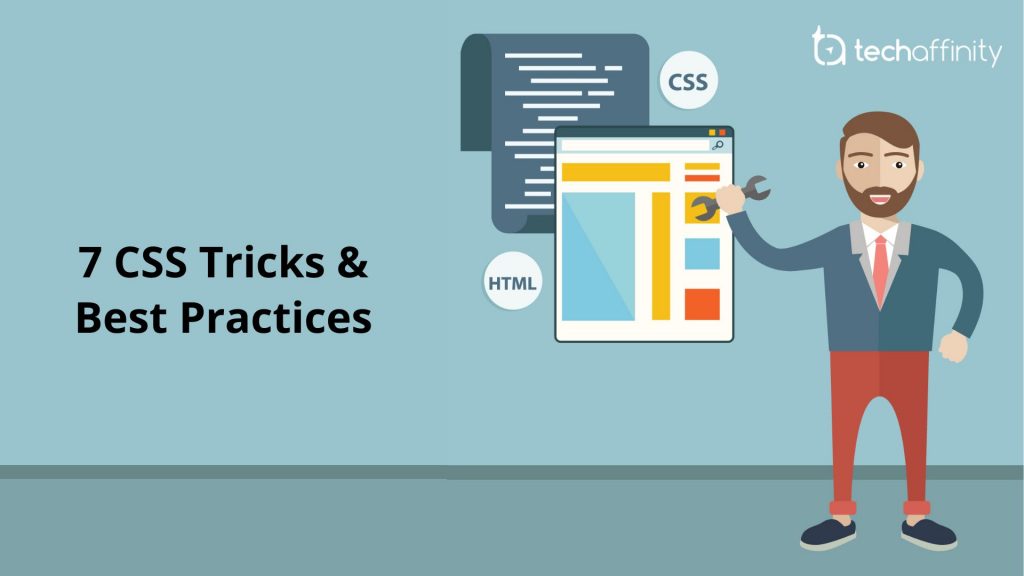Remember these 7 CSS Tricks & Best Practices for Glitch-free Front-end Development

Author : John Prabhu 21st Oct 2019

HTML & CSS are the predominant languages for any newbie front-end developer to learn. With these technologies, you can get your hands dirty on building the front-end of websites and web apps. CSS unpacks a distinctive cascading structure, and it is easy to understand and follow. When you get your hands on CSS and start experimenting with it, be prepared for the complexities you are about to create. Here are 7 major CSS tricks you need to know before experimenting with CSS.
1. MASTER THE CSS TRICK: ABSOLUTE POSITIONING
If there is one thing that seeks a front-end developer’s attention continuously, it is the device-agnostic nature of the UI elements. You need to learn and master absolute positioning completely to have consistency in your front-end design. A simple illustration of the CSS trick is given below:
div.absolute {
position: absolute;
top: 85px;
right: 65px;
width: 205px;
height: 105px;
}
The above example represents that the website elements remain 65px away from the right, and 85px away from the top edges of the page. Further, the dimensions of the <div> element is 205px wide and 105px high. Also, you will be able to use the “absolute” code in your <div> element.
2. LEARN THE CSS TRICK: RESIZING IMAGES
CSS is great to handle media files if you master its basics completely. Whenever you are required to adjust images for a specific width and scale it according to certain proportions, it is one of the CSS best practices to use max-width. A simple illustration of the CSS trick is given below.
img {
max-width: 100%
height: auto;
}
Leveraging this strategy instructs the browser to assign the maximum width of the image to be 100%, and instructs it further to automatically calculate the height of the image.
3. WRITE A CSS PROPERTY & APPLY IT TO MULTIPLE CLASSES
Let’s assume a scenario where you are required to add borders of the same style to the blog section, images on your entire website and sidebar. In this case, you can take advantage of the commas and write the desired style for the above-mentioned sections. A simple illustration of the CSS trick is given below.
.img, .blog, .sidebar {
border: 1px solid #001;
}
It is an effective method to use when you are piled up with a website or more requiring several web pages. Though it looks simple, it has the potential to save your time and increase productivity.
4. SAVE TIME BY INSPECTING ELEMENTS
To ensure that no CSS properties are repeated or used unnecessarily, you have to get familiar with the developer tools that come bundled with your browser. With options to inspect various HTML elements, you can witness the CSS properties applied to the elements in real-time. With the help of checkboxes, you can remove and add certain pre-written elements then and there and try them without changing your actual code.
5. CHOOSE THE IDE & RELATED TOOLS THAT YOU ARE COMFORTABLE WITH
Along with writing CSS codes, you also have to compile, format, and manage your code well. Explore a few Integrated Development Environments (IDE) and select the one with which you can work seamlessly.
You, as a CSS developer, are as good as your choice of tools. Only when you’re comfortable with your tool, you will then feel confident. With confidence, you can unleash the full potential of CSS.
6. ENSURE CROSS-BROWSER COMPATIBILITY
Understand how your preferred browser renders your CSS codes in the first place. It helps you boost your CSS skills quickly and lets you inspect, debug, and manage your website with ease. Every browser is different and you, as a front-end developer, are expected to understand them completely.
7. LEARN & UNDERSTAND CSS TRICKS BEFORE GETTING INTO FRAMEWORKS
Undoubtedly, CSS frameworks such as Bootstrap, Materialize, Bulma, etc. reduce the time you spend on coding and make it relatively easy for you to finish off the development process. But, without the practice of basic CSS codes and functionalities, you might be complicating things instead of solving them with simple & basic codes. So, it is recommended to get hands-on experience in writing CSS codes and then move on to frameworks.
Ensure that you remember these CSS tricks and CSS best practices while starting your next project. At TechAffinity, we have a team of expert front-end developers who are familiar with all these CSS tricks and best practices. With our team, it is relatively easy and quick to develop websites and web apps for various industry requirements. Drop your queries at media@techaffinity.com or schedule a meeting with us.
